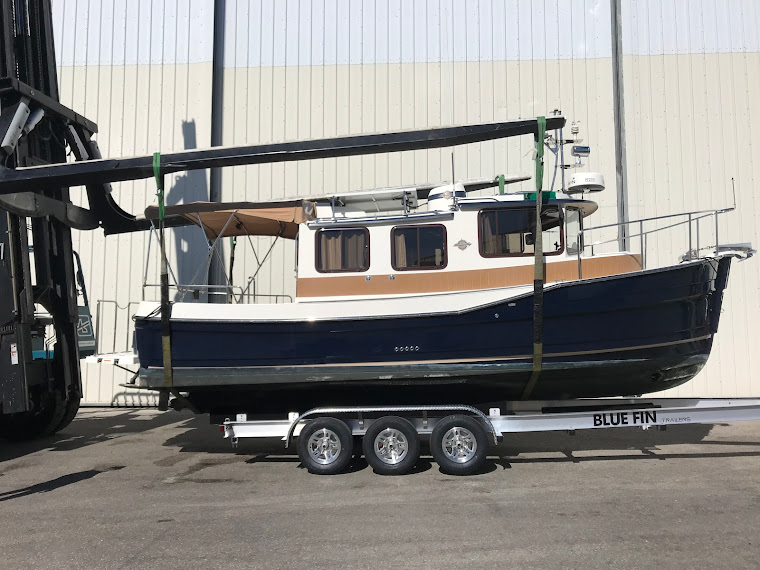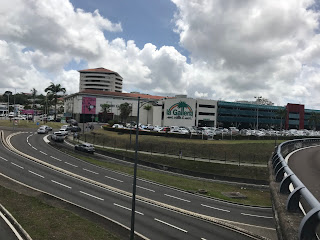Another
stop in the land of croissant
Martinique
like the other French islands is really French.
They are citizens of France so checking in here is as easy as traveling
to France and just as tasty with a little added spice.
Our
first stop in Martinique was St Pierre in the shadow of Mount Pelée. This
volcano erupted with devastating result on May 8th 1902. The town at that time was the capitol of the
island with impressive wealth and commerce.
Today a few ruins tell the story of the nearly 30,000 people who died in
this disaster. Photo of
museum interior - bell salvaged and wall engraved with names of those who died
The
newly renovated and most impressive Monument Museum next to the ruins of the
theater displays artifacts and photos of the eruption accompanied by audio
recordings of post cards and histories of the event. Although there were a few
survivors, Cyparis who was in jail for murder and lived through the fire, mud
and ash in his cell, was paraded by the circus as the only man to live through
the eruption. We also walked through the remains of the massive theatre built
in the mid-1700s. It sits next to the jail cell bunker where “the survivor” was
sheltered by the thick concrete walls.
 |
| bunker JAIL |
We
also walked out of town to the Depaz Distillery built on the remnants of the
family estate – the founder of the distillery, Victor Depaz, lost his entire
family in the eruption of 1902 while he was in Paris studying. Although he intended to move to Canada, his
ship had to make an emergency stop in Martinique which he took as a sign he
should remain in his native island. His
“rhum” has endured and this family business frequently wins awards for
traditional rhum agricol – made directly from the sugar cane harvested on the
island. They have a convenient and
-marked tour of the distillery and the processes plus a stop at the family
chateau sitting on the hill above the factory.
 |
| mixing a Ti Punch |
The 45-minute uphill walk was
worth the effort and helped justify all the treats from our favorite
boulangerie – The Baguet Shop. Returning to town we wandered though the Rasta
Marche (Market) being held in the city center.
The stalls were selling all things Rastafarian from good eats to head
dresses and assorted other fashion items. It wasn’t necessary to indulge in
consumption of herbal substances – just breathing probably gave us some of the
“angels share”.
Steve
joined the local dive group for a morning outing which he said was okay – but
still not up to Saba standard.
 |
| Mt Pelee with his head in the clouds |
In
transit to the capitol city of Fort de France, we spent a quiet night (after
the bars with loud music closed) off Le Carbet just a few miles south of St
Pierre. This made our run into the
spacious anchorage off Fort St Louis a short, short day. We used the leisure to catch up on laundry
although Steve did manage to hunt down a boulangerie for our morning treats.
During our time here, we took advantage of the local tourist office’s audio
tour – available in English to visit most of the historic sights in town. This
is a self-guided tour with a “smart” wand that when touched to the sight on the
map provided, educated us on the history of the building and its architecture.
We stopped at the most “grand” Schoelcher Library and the St Louis church both
metal structures – a response to the fires that destroyed the town. The
intricacy of these buildings and the decorative details were impressive. The library was created by Gustave Eiffel of
the tower fame. It was first displayed at an exhibition in France, then
disassembled and shipped to Martinique, and finally re-constructed in its
present home. It is a credit to the French government and the people of
Martinique that these 19th century treasures have been preserved.
We
also were lucky to get a guided personal tour of fort St Louis. Since it is an active French Navy base our
tour was limited to outer areas of the old walls but we definitely got a feel
for life as the soldiers lived from its earliest occupation in the 1600s. It
was impressive to look down on our tiny boat from the walls of the fortress and
contemplate the lives of the many who occupied this strategic point over the
years.
 |
| A welcome to arriving French ship! |
In one museum we learned about
the Ameri-Indians (Caribs) who lived here before the arrival of Europeans. For
a little over 20 years between 1634 and 1658 the two groups actually divided
the island of Martinique and managed to live somewhat peacefully together. However, in the end the superior weapons and
desire for the rich land, resulted in decisive victories over the Caribs – those not killed retreated to Dominica and St
Vincent where remnants still survive today. The sophistication of their
cultural artifacts as represented in the museum testify to our loss. Although
they did not have the weapons of the Europeans, they cleverly used all the
local products to fashion useful as well as decorative items for their daily
lives. Also, many words and agriculture products from the Caribs are still a part
of the French and English lexicon today. It is sobering to imagine what they
could have taught us if we had approached them with more mutual respect.
We
took a break in the charming lobby café of the Hotel L’Imperatrice an Art Deco
style 1950’s building – just one of many casual and relaxing places in Fort de
France for the hard-working tourist or local.
Another
excursion took us out to the Galleria on the new TCSP tram – a $3 round trip
took us from the exotic to the “anywhere in the world MALL” experience. We had
a strange feeling that we could be in almost any big city in the world – only a
few signs in French located us, but not much made it Caribbean. The French
fashions did catch Admiral’s eye and although tempting most would sadly not be useful
on a boat.
Seeking
a quiet day, we stopped at Anse Noir but were joined by several boats in party
mode on this May 22nd holiday – Abolition Day. The cozy anchorage was still charming with
crystal clear water. Although not the
quiet day we expected, everyone seemed to be enjoying themselves – including
the folks jumping from the cliffs.
We
did have to move before sunset to the larger open area at Grand Anse d’Arlet so
we did not disturb the fish in the morning when the fishermen were coming to
catch them. The local fisherman came
with his cute your female translator to ask us politely to move. Never hurts to
have a bikini clad assistant make this kind of request! The move made for a
shorter run to our next stop at Sainte Anne at the south end of Martinique, so
it wasn’t really any problem.
Passing the famous SHIP ROCK - disguised to be a ship to attack the enemy:
Another
wide open and expansive anchorage just packed with boats – fortunately not too
close so everyone had some privacy. The
town has a beautiful dock for dinghy access to this cute little village. One of
the “activities” here is a walk/hike up the hill on the path that is marked
with the stages of the cross.
The steep
path is well worth the climb for the view and the breeze. Busses run from here to the larger commercial
center of Le Marin – we could have moved the boat into this very protected
harbor, but since the weather was fine, we opted to stay at St Anne and bus in
to visit the chandleries and shops. In the end we made two trips. The second
because the local shop with the customs computer was taking a vacation, so we
had to clear out at the marina in Le Marin. No worries - this gave us one more chance to visit the big
grocery stores and stock up on French goodies before heading on south.
 |
| cute St Anne |
 |
| Friday drinks with other cruisers |




























going to b at south end of st vincent YOUNG ISLAND RESORT, july 6-13. are u in the neighborhood??
ReplyDeleteleft off name: bob neff, rhn2@cornell.edu
ReplyDelete